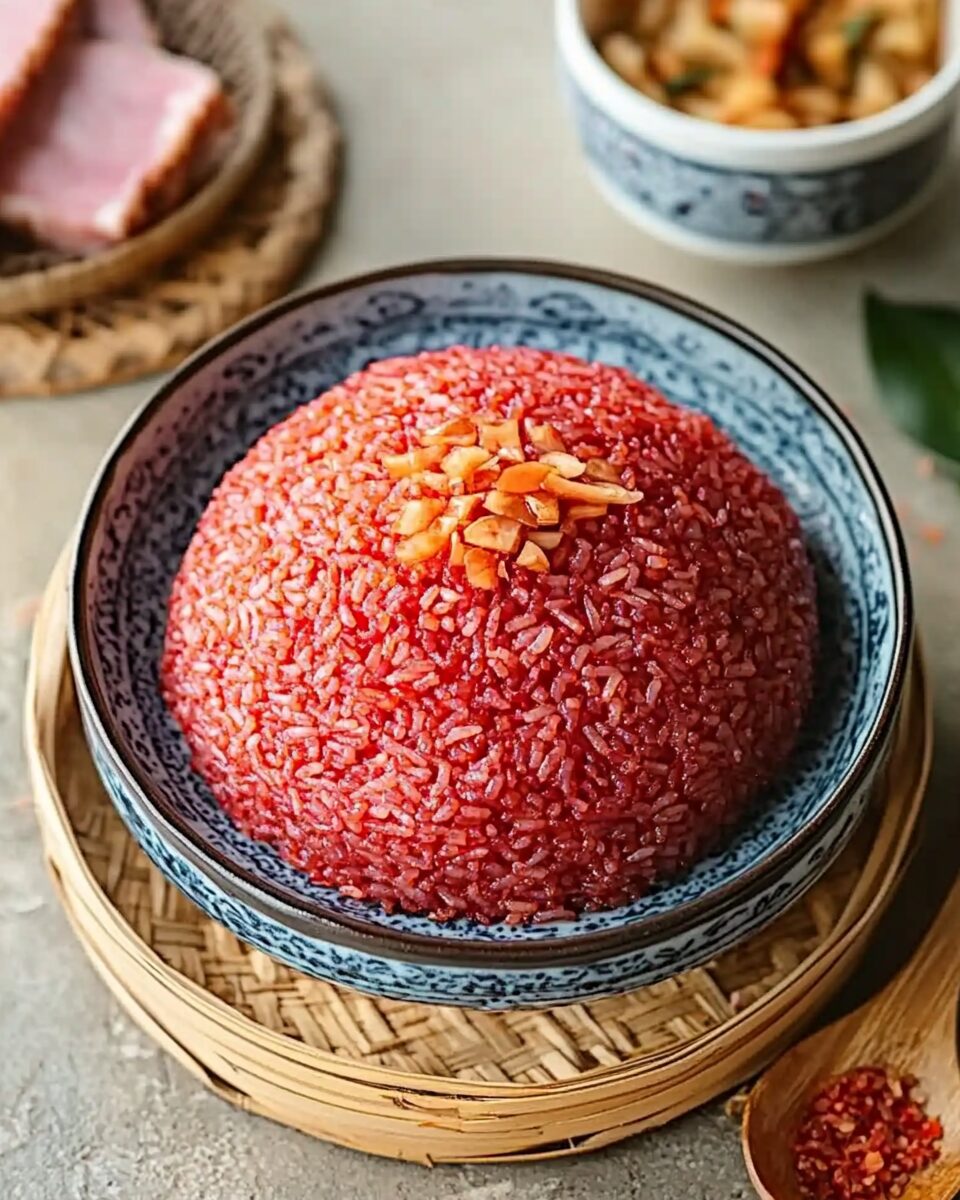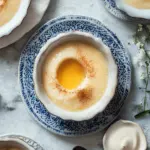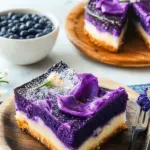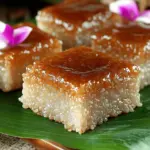Xôi Gấc is a vibrant Vietnamese red sticky rice traditionally served during festive occasions like Lunar New Year (Tết). The red hue, symbolic of good luck, comes from the unique Gấc fruit—specifically its red arils surrounding the seeds. Steamed with sticky rice, the result is a lightly sweet, subtly fruity, and richly colored dish that’s both meaningful and delicious. It’s often paired with savory proteins like Vietnamese ham or roasted chicken for a complete celebratory meal.
Full Recipe:
Ingredients
-
1¾–2 cups sticky rice (glutinous rice), ~12–14 oz
-
7 oz Gấc fruit seeds (~1 cup) (fresh or thawed from frozen)
-
2 tbsp rice wine (or white wine or sake)
-
¾ tsp salt
-
2 tsp neutral oil
-
2–3 tsp sugar (adjust to taste)
Directions
-
Soak the Rice:
Rinse sticky rice thoroughly and soak in plenty of water for at least 2–4 hours, preferably overnight. Drain well before cooking. -
Prepare Gấc Paste:
Place red Gấc seeds in a bowl. Add rice wine, salt, and oil. Stir and beat with a spoon for 3–5 minutes until a red paste forms and dark seeds are exposed. -
Mix with Rice:
Combine the drained rice with the Gấc paste. Stir well and let sit for 5 minutes to absorb color and flavor. -
Steam:
Transfer the mixture to a steamer basket lined with cheesecloth or banana leaves. Steam for 15–20 minutes. -
Add Sugar:
Open steamer lid, sprinkle sugar evenly over rice, and stir gently. Taste and adjust seasoning as needed. Steam an additional 5–10 minutes until soft. -
Serve:
For traditional presentation, pack the sticky rice into a bowl and invert onto a plate for a dome shape. Serve hot.
Optional Accompaniments:
-
Vietnamese ham (giò lụa)
-
Roasted peanuts & sesame seeds (muối vừng)
-
Poached or roasted chicken
-
Braised pork belly with eggs
Nutrients (approximate per serving, based on 6 servings)
-
Calories: ~210 kcal
-
Carbohydrates: ~40g
-
Fat: ~3g
-
Protein: ~4g
-
Sugar: ~3g
-
Sodium: ~150mg
-
Fiber: ~1g
Flavor Profile and Texture
At first glance, the vibrant red color of Xôi Gấc can be striking, but its flavor is far more subtle and comforting than it appears. The sticky rice, when cooked with the red Gấc paste, develops a very light sweetness and gentle floral-fruity aroma. It is not overpowering; instead, the taste is nuanced—earthy and warm with a hint of tropical fruitiness, which complements both sweet and savory dishes.
Texturally, the rice is soft, sticky, and cohesive—characteristic of properly steamed glutinous rice. The added oil during the preparation stage gives it a lovely sheen and a rich mouthfeel, while the sugar added towards the end enhances the natural sweetness of the Gấc without making the dish overtly sugary. The dish is traditionally served warm and can either be enjoyed on its own or accompanied by a range of proteins and condiments, making it versatile for any meal occasion.
Traditional Accompaniments and Serving Customs
In its purest form, Xôi Gấc is often molded into a bowl and inverted onto a plate, forming a compact dome that showcases the rice’s glossy red surface. However, its presentation can vary depending on the occasion. For weddings, it might be shaped into hearts or lotus flowers, while on New Year’s it is often adorned with edible gold leaf or sesame peanut salt.
The rice is frequently served alongside savory proteins. Giò lụa (Vietnamese ham) is a popular pairing because its delicate pork flavor balances the rice’s mild sweetness. Roasted chicken or poached chicken with ginger fish sauce is another favored match, particularly for festive family meals. Some families serve Xôi Gấc with braised pork belly and boiled eggs, giving a rich and hearty contrast to the tender rice. A sprinkle of roasted peanuts and sesame seeds (muối vừng) can also be added for crunch and extra umami depth.
Why This Dish Stands Out
One of the most unique aspects of Xôi Gấc is its ability to combine visual elegance, cultural significance, and healthful ingredients into a single dish. Unlike most celebratory foods that lean heavily into indulgence, this sticky rice is naturally gluten-free, low in fat, and high in beneficial carotenoids due to the Gấc fruit. Its preparation doesn’t require complex techniques or specialized equipment, making it accessible to home cooks who want to explore authentic Vietnamese cuisine.
What sets this dish apart is how easily it adapts to different dietary needs and cultural settings. Whether served as a side dish, centerpiece, or even dessert (by increasing the sugar and pairing it with coconut cream), Xôi Gấc fits seamlessly into many menus. Its unique color also makes it ideal for themed events or holiday tables.
Health Benefits of Gấc Fruit
The Gấc fruit, while not widely known outside Southeast Asia, is gaining recognition in wellness circles for its rich antioxidant content. It contains one of the highest concentrations of lycopene—more than tomatoes—as well as beta-carotene. These compounds support healthy skin, eye function, and immune defense, making Xôi Gấc not only visually appealing but beneficial from a nutritional standpoint.
Furthermore, glutinous rice, though dense in carbohydrates, is low in cholesterol and can be a good energy source, especially during holidays or physically demanding days. When balanced with lean protein accompaniments, it becomes a wholesome and sustaining meal.
Modern Takes and Adaptations
In recent years, modern interpretations of Xôi Gấc have appeared in fusion cuisine. Some chefs use it as a base for sushi, pairing it with seafood and wasabi mayo for a colorful twist. Others have transformed it into dessert forms—layering it with coconut cream, mung bean paste, or wrapping it in banana leaves for portable snacks.
Home cooks have started adding a splash of coconut milk during the steaming process to enrich the flavor or using molds to create individual portions for party platters. Vegan adaptations are also popular, replacing traditional animal proteins with marinated tofu or mushrooms.
These innovations show that Xôi Gấc remains a vibrant part of Vietnam’s evolving food scene—respected for its history, yet open to creativity.
Popularity Beyond Vietnam
As global interest in traditional Asian foods grows, Xôi Gấc has begun appearing in international food blogs, cooking channels, and even fusion restaurant menus. Its stunning red-orange color is naturally photogenic, making it ideal for food photography, especially during holidays or themed dinners. Vietnamese communities abroad often prepare Xôi Gấc for their New Year celebrations, helping preserve cultural identity across generations and continents.
Food tourism in Vietnam also plays a part in the dish’s rising fame. Visitors are often introduced to Xôi Gấc at traditional markets or local households during Tet celebrations, where it leaves a lasting impression due to both its taste and symbolic weight.
Serving Suggestions for the Perfect Experience
To fully enjoy Xôi Gấc, serve it warm with a contrasting savory dish. Vietnamese ham slices, roast chicken, or tofu skewers offer excellent balance. A small bowl of soy sauce or fish sauce on the side enhances the flavor even further. For textural variation, top the rice with roasted peanuts or fried shallots.
For a more festive presentation, mold the rice into individual domes using ramekins or small bowls. Garnish with sesame seeds or edible flowers for visual appeal. You can also serve it buffet-style with small labels explaining the cultural significance for guests unfamiliar with the dish.
Leftovers can be reheated by steaming again or wrapped in banana leaves for a rustic look and added aroma.
Conclusion
Xôi Gấc is more than a traditional Vietnamese recipe—it is a heartfelt expression of celebration, prosperity, and cultural pride. Its natural red hue, gentle sweetness, and soft texture make it a standout at any feast, especially during Tết or weddings. What makes it even more remarkable is its nutritional value and adaptability. Whether you’re preparing it to honor tradition or exploring new global flavors, Xôi Gấc offers a delicious, healthful, and visually stunning addition to any table.
Its story, symbolism, and sensory appeal ensure that this humble yet powerful dish will continue to be passed down, celebrated, and reimagined for generations to come. Whether enjoyed at home, shared with loved ones, or presented to curious guests, Xôi Gấc is always a beautiful reminder of Vietnamese culinary heritage.






